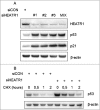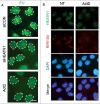Perturbation of RNA Polymerase I transcription machinery by ablation of HEATR1 triggers the RPL5/RPL11-MDM2-p53 ribosome biogenesis stress checkpoint pathway in human cells
- PMID: 29143558
- PMCID: PMC5815431
- DOI: 10.1080/15384101.2017.1403685
Perturbation of RNA Polymerase I transcription machinery by ablation of HEATR1 triggers the RPL5/RPL11-MDM2-p53 ribosome biogenesis stress checkpoint pathway in human cells
Abstract
Ribosome biogenesis is an energy consuming process which takes place mainly in the nucleolus. By producing ribosomes to fuel protein synthesis, it is tightly connected with cell growth and cell cycle control. Perturbation of ribosome biogenesis leads to the activation of p53 tumor suppressor protein promoting processes like cell cycle arrest, apoptosis or senescence. This ribosome biogenesis stress pathway activates p53 through sequestration of MDM2 by a subset of ribosomal proteins (RPs), thereby stabilizing p53. Here, we identify human HEATR1, as a nucleolar protein which positively regulates ribosomal RNA (rRNA) synthesis. Downregulation of HEATR1 resulted in cell cycle arrest in a manner dependent on p53. Moreover, depletion of HEATR1 also caused disruption of nucleolar structure and activated the ribosomal biogenesis stress pathway - RPL5 / RPL11 dependent stabilization and activation of p53. These findings reveal an important role for HEATR1 in ribosome biogenesis and further support the concept that perturbation of ribosome biosynthesis results in p53-dependent cell cycle checkpoint activation, with implications for human pathologies including cancer.
Keywords: HEATR1; cancer; p53; ribosome biogenesis; ribosome biogenesis stress.
Figures





Comment in
-
New insights into HEATR1 functions.Cell Cycle. 2018;17(2):143-144. doi: 10.1080/15384101.2017.1411325. Epub 2018 Jan 2. Cell Cycle. 2018. PMID: 29235920 Free PMC article. No abstract available.
Similar articles
-
The roles of RRP15 in nucleolar formation, ribosome biogenesis and checkpoint control in human cells.Oncotarget. 2017 Feb 21;8(8):13240-13252. doi: 10.18632/oncotarget.14658. Oncotarget. 2017. PMID: 28099941 Free PMC article.
-
Ribosomal protein L4 is a novel regulator of the MDM2-p53 loop.Oncotarget. 2016 Mar 29;7(13):16217-26. doi: 10.18632/oncotarget.7479. Oncotarget. 2016. PMID: 26908445 Free PMC article.
-
Activation of the tumor suppressor p53 upon impairment of ribosome biogenesis.Biochim Biophys Acta. 2014 Jun;1842(6):817-30. doi: 10.1016/j.bbadis.2013.08.014. Epub 2013 Oct 26. Biochim Biophys Acta. 2014. PMID: 24514102 Review.
-
Acrolein preferentially damages nucleolus eliciting ribosomal stress and apoptosis in human cancer cells.Oncotarget. 2016 Dec 6;7(49):80450-80464. doi: 10.18632/oncotarget.12608. Oncotarget. 2016. PMID: 27741518 Free PMC article.
-
A new PICTure of nucleolar stress.Cancer Sci. 2012 Apr;103(4):632-7. doi: 10.1111/j.1349-7006.2012.02219.x. Epub 2012 Mar 8. Cancer Sci. 2012. PMID: 22320853 Free PMC article. Review.
Cited by
-
New insights into HEATR1 functions.Cell Cycle. 2018;17(2):143-144. doi: 10.1080/15384101.2017.1411325. Epub 2018 Jan 2. Cell Cycle. 2018. PMID: 29235920 Free PMC article. No abstract available.
-
Systemic response to rupture of intracranial aneurysms involves expression of specific gene isoforms.J Transl Med. 2019 May 2;17(1):141. doi: 10.1186/s12967-019-1891-6. J Transl Med. 2019. PMID: 31046777 Free PMC article.
-
A high-throughput assay for directly monitoring nucleolar rRNA biogenesis.Open Biol. 2022 Jan;12(1):210305. doi: 10.1098/rsob.210305. Epub 2022 Jan 26. Open Biol. 2022. PMID: 35078352 Free PMC article.
-
MeCP2 facilitates breast cancer growth via promoting ubiquitination-mediated P53 degradation by inhibiting RPL5/RPL11 transcription.Oncogenesis. 2020 Jun 1;9(5):56. doi: 10.1038/s41389-020-0239-7. Oncogenesis. 2020. PMID: 32483207 Free PMC article.
-
Discovering root causal genes with high-throughput perturbations.Elife. 2025 Mar 5;13:RP100949. doi: 10.7554/eLife.100949. Elife. 2025. PMID: 40042510 Free PMC article.
References
Publication types
MeSH terms
Substances
LinkOut - more resources
Full Text Sources
Other Literature Sources
Research Materials
Miscellaneous
